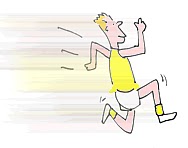How do you get ready for exercise?
Recommendations to stretch or not stretch change from year to year and from expert to expert. Stretching has been promoted for years as an essential part of a fitness program as a way to decrease the risk of injury, prevent soreness and improve performance. While researchers continue to look at the benefits and pitfalls of stretching, there is still limited (and conflicting) evidence to sort out these opinions.
Much of this confusion comes from a misinterpretation of research on warm up. These studies found that warming by itself has no effect on range of motion, but that when the warm up is followed by stretching there is an increase in range of motion.
Many people misinterpreted this finding to mean that stretching before exercise prevents injuries, even though the clinical research suggests otherwise. A better interpretation is that warm up prevents injury, whereas stretching has no effect on injury.
If injury prevention is the primary objective the evidence suggests that athletes should limit the stretching before exercise and increase the warm up time.
“What ever your sport, the bottom line on warming-up and stretching: what ever you do, just make sure your body is 100% ready to perform at its optimal state before the gun goes off.”
So how should we warm up?
It all depends on what your about to take part in, sport-specific movements. If your heading out on a maintenance run at a slow pace then you can start with a very slow jog and after 5 minutes complete some heels to bum, high knees side steps to warm up and get all the muscle in your legs to optimal length. However if you have been roped into a ‘Dad’s’ game of rugby then you will not only have to warm up your legs but your hole body. Think about the sport your about to take part in (rugby in this instant) and what range of movement/motion the body goes through. Sprinting, jogging, tackling, pushing and pulling, getting off the ground, getting taken to the ground! As you can see your body will be but through its paces so we need to replicate some of these moves before to prepare before whistle goes. Jogging, side stepping, press ups, sits, on and off the ground laying alternately on front or backs, sprinting jumping and changing of direction.
Again, it’s all a matter of getting the core temperature up, and feeling loose. The muscles must be at optimal length, and ready to perform the full range of motion required for the event.
But one of the biggest benefits of stretching may be something the research can't quantify: it just feels good.







